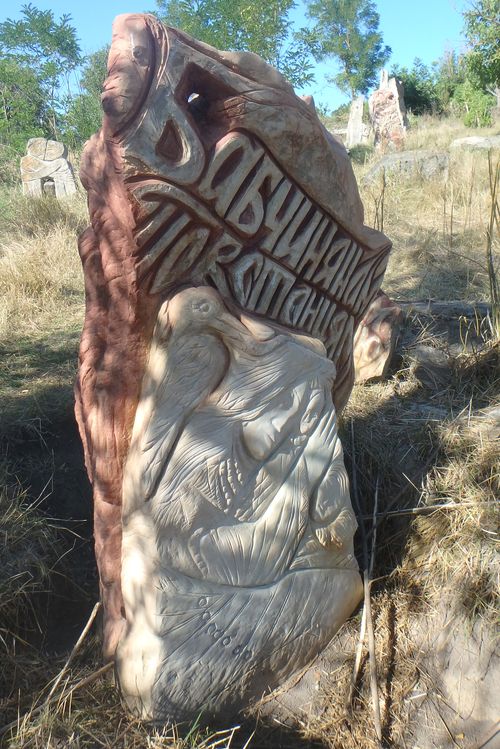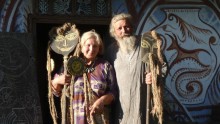“What is the most important thing for a person?” Oleksii Alioshkin asks in a strict tone of a teacher at the gates. Noticing my confusion, he smiles softly and says, “Freedom.” It was freedom that made a young couple of sculptors to exchange a cozy flat into an old house in Bukatynka village, which is located at the rocky banks of Murafa. The Alioshkins never regretted about their decision. Now they are living in harmony with the surrounding world and continue to create beautiful things – in Bukatynka, they established a sculpture park on the territory of several abandoned households, painted over the houses, and opened a museum in each of them. They say in the village “the sacred place is preserved, because every person must fight for each spiritual one, like a cyborg fighter.”
“OUR MAIN TASK WAS TO DEVELOP CREATIVE FINDINGS”
The Alioshkins have been living in Bukatynka for nearly 40 years. They own six houses with stone sculptures rising proudly in every yard. Young people leave the village, old people die, leaving the houses that no one needs. To prevent the houses from ruination, the Alioshkins turn them into amazing art objects, decorated the shabby walls with Podil and Trypillia ornaments. They opened a museum in every house. In one of them they established a unique shadow museum. In the second one you can create sand pictures, the third one houses a history museum with an oven painted with pictures of roosters. A bit further there is a museum of ceramics and pottery with hundreds of whistles, pots, and jars. They were donated by people and gathered by children during the hikes organized by the Alioshkins. And one more house is a museum of motanka doll and embroidery. Inside the houses, everyone having its own legend and energy, the floors are covered with aromatic hay.

“At first we decorated our own house. We depicted four seasons on four walls. Spring in the east is our youth, summer in the south means happy family life, winter in the north is our routine, and autumn in the west is golden maturity and life wisdom,” Liudmyla Alioshkina says, “All ornaments in the houses and inside of them have their specific meanings. There are interesting and funny stories. One girl from Kyiv, who was staying with us, depicted herself and her boyfriend. She painted his ears on the top of his head. That surprised us, why she did that, and she replied, ‘Because he can’t hear me.’ Only the one who reached a higher level of art and love, switched on the imagination and looked at the world with different eyes can understand every work.”
Except for the traditional Ukrainian museums Alioshkins organize philosophical entertainment. It includes different ropes, hanging everywhere, swings, and bungees across the river. The philosophy is simple: the rope can jerk, and the person will either fall or go up to a roof, to the heaven, and won’t be able to go down.
“It’s like in life, if the person loses connection with God, s/he may get lost in this world and suffer,” Alioshkin contemplates, “In this museum with a symbolical title ‘Seventh Heaven’ the person must imagine. And our main task now is to develop creative findings. They say, ‘To live in a new way,’ better or worse, but the most important thing is to leave creatively. Then we won’t be picking up Polish or German experience, but we will be looking and developing on our own. Creativity is the main engine in the development of the humankind.”
PERUN ON AN OAK
“They often ask me, how could I refuse from a career and a workshop in the center of Kyiv, to live in a village with no conditions for life? But does creative work need conditions? Do you know what the difference between a master and an artist is? The first one is working for a reward, the second one – for the sake of creativity. I am not bound with money, I am free in my ideas, and this is the greatest benefit,” the sculptor said. “For example, on my way I saw that someone scratched an oak, I ‘mended’ it creating the Perun image on its bark. Now they maybe won’t dare to touch the tree, because this is a culture object. And how many bad words have I removed from the sandstones decorating the banks of the Murafa?” And now they show the images of a beauty, a goddess, and the faces of lovers.

It is impossible to count all art objects located on the territory of the Alioshkins’ creative lab. They say their stonecutting works can be used to write theses on the development of sculpture in Ukraine. Alioshkin jokingly calls the 18-meter-deep well he dug on his own near his house his most important sculpture. Nearly in every house there is a cellar, and an underground tunnel. The wife says jokingly that Alioshkin for sure must have been a miner dwarf in his previous life.
TO TEACH TO THINK
Until recently Alioshkin has been teaching history, law, physical training at the local village school, whereas his wife Liudmyla was teaching handicrafts, drawing, and also led a club of Ukrainian folk toys. But this year the school was closed, because very few children were left. But the couple is not going to lose ties with the kids, they organize master classes, tours, creative evenings for educating the future generation.
“Long time ago Dovzhenko said that between the truth and the beauty he chooses beauty. It possesses deeper truth than just bare truth. I have the same opinion, because everyone may have a truth of his own, but beauty is eternal,” the sculptor says, “We create beauty like birds sing the song. Not to forget how to sing, to preserve the Ukrainian traditional culture, to teach children how to think. During the tours I take the children to a dark cellar and tell them how in their time Cossacks were hiding from Tatars, and now our soldiers in the frontline are hiding underground from the enemies’ bullets. Children must understand and feel life, for this one must talk to them, talk a lot and ask correct questions. Some of the kids asked me, when the war will be over? I didn’t philosophized, but told them an Ancient Greek myth: when nine muses gathered at one table and played one melody, the war god Ares put his sword to their feet and bowed. Every wise person should make conclusion of their own. People like muses must unite in one striving. The most important thing is to pay attention to what unites, rather than disunites, us.”
As you get to Bukatynka (previously the village was called Bohatynka, i.e., God’s house or God’s place) you get convinced that this place is really a chosen one. The Alioshkins gave birth to five children: Petro, Daryna, Oleksii, Hanna, and Mykhailo. All of them are involved in the artistic work in different corners of Ukraine. This place lacks amenities, the mobile phone connection is instable, the people never heard about the Internet. It seems that the time has stopped. It gives you a chance to think about the eternal and high things, get rid of the unnecessary and clean your thoughts. You say it’s impossible, but you should check for yourself. The Alioshkins will help you.







